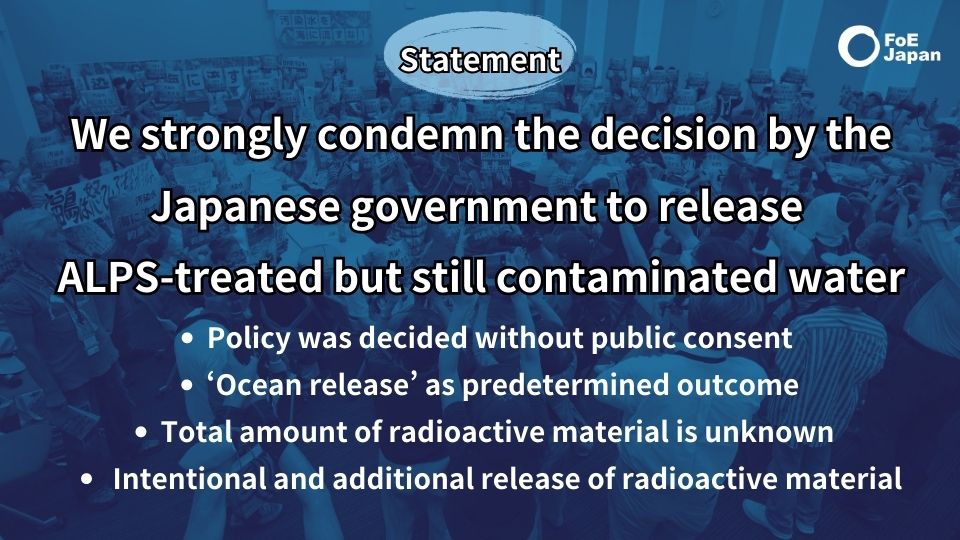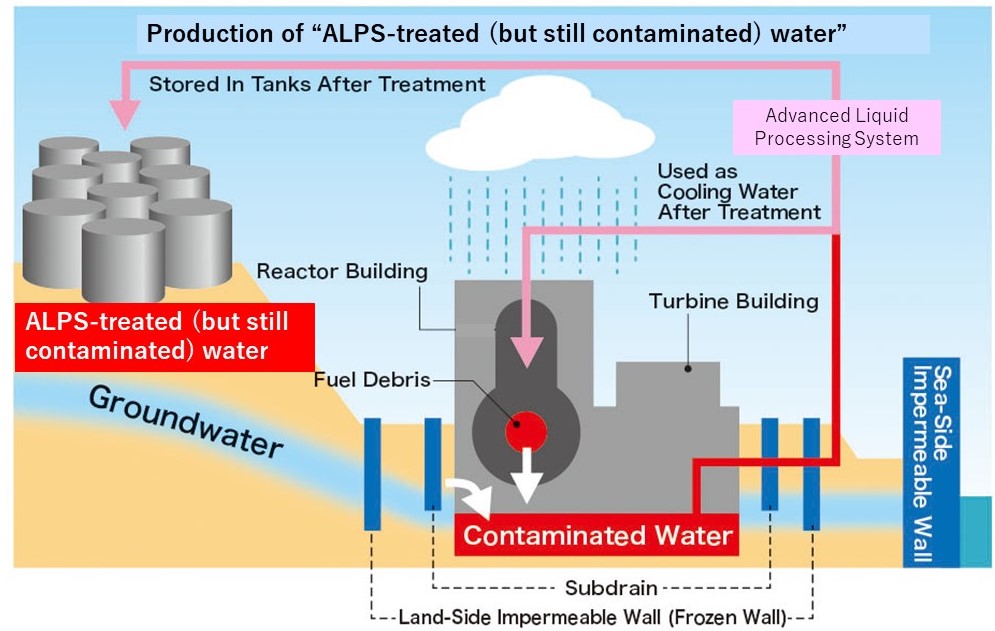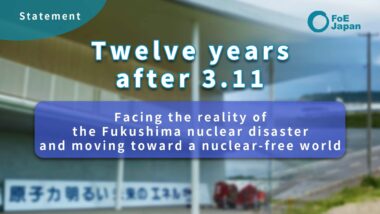Statement: We strongly condemn the decision by the Japanese government to begin releasing ALPS-treated (but still contaminated) water into the ocean -"Understanding of the relevant parties" has not been obtained-
August 22, 2023

Today, at a meeting of relevant ministers, the Japanese government decided to begin releasing ALPS (Advanced Liquid Processing System) – treated (but still contaminated) water (Note 1) stored in tanks at the Fukushima Daiichi (No. 1) nuclear power plant into the ocean as early as August 24. There was no public discussion of alternatives, such as mortar solidification. Only the “ocean release” option was pushed forward. The government and TEPCO had promised not to take any action without the understanding of relevant parties, but that promise has been broken. There have been no public hearings since August 2018. We strongly protest this decision made in disregard of the voices of opposition and concern in Japan and abroad, including fishers.
1. Policy was decided, then “understanding” imposed
In 2015, TEPCO and the Japanese government promised the Fukushima Federation of Fisheries Cooperative Associations (“Kengyoren”) that “ALPS-treated water” would not be disposed without the understanding of the relevant parties (Note 2). They have since repeatedly said they will keep their word.
It is not clear who the “relevant parties” refer to, but they would include all concerned citizens in Japan and abroad, including the affected fishers and people in Fukushima.
In response to Prime Minister Fumio Kishida’s statement on August 7 that the relationship based on trust with the fishing industry is gradually deepened, Tetsu Nozaki, head of Kengyoren, said, “I don’t know what he’s referring to.” (Note 3)
On August 20, Prime Minister Kishida visited the Fukushima Daiichi nuclear power plant and exchanged views with senior officials of TEPCO, but did not meet officials of Kengyoren.
After a meeting with the Japan Federation of Fisheries Cooperative Associations (“Zengyoren”) on May 21, Prime Minister Kishida said that the understanding of related parties is progressing to some extent.
It is not acceptable to make such remarks without meeting local fishers.
Both Kengyoren and Zengyoren have repeatedly expressed their opposition to the ocean release. For four consecutive years, they have adopted special resolutions against the release (Note 4). In addition, in July 2023, the Soma Futaba Fisheries Cooperative conveyed its “firm opposition” to the government (Note 5).
More than 70% of municipalities in Fukushima Prefecture have adopted statements, and many of them are opposing or urging caution in the release of treated (but still contaminated) water.
In August 2018, the government held “briefings and hearings” at two locations in Fukushima and one in Tokyo, and of the 44 people who expressed their opinions, 42 were clearly opposed to ocean releases. No hearings have been held since then.
Thus, the understanding of related parties has not been obtained.
This decision process is nothing more than deciding on the policy first and then imposing it on related parties.
2. ‘Ocean release’ as predetermined outcome of review process
Looking back at the series of review processes in committees organized by the government, the consideration of alternatives was very superficial, and conclusions were always guided toward “ocean release.“ In 2018, five proposals were compared. One of them was ocean release, at an estimated cost of 1.7 billion to 3.4 billion yen and a duration of 52 to 88 months (Note 6), making it the lowest cost and shortest duration of the five proposals. Since then, however, the current estimate of cost has ballooned to at least 120 billion yen (Note 7), more than 35 times the initial calculation. Meanwhile, the release period in TEPCO’s simulations is now estimated at more than 30 years (i.e., 360 months).
In addition, proposals for “large tank storage “ and “mortar solidification“ (Note 8) presented by the Citizens’ Commission on Nuclear Energy, which includes engineers and researchers, were not given the least amount of formal consideration, despite arguably being realistic options.
3. Unknown total amount of radioactive material to be released
Not only tritium but also radioactive substances such as cesium-134, cesium-137, strontium-90, and iodine-129 remain in the water in tank storage, and about 70% of the water in tank storage has radionuclide concentrations exceeding ocean discharge regulatory standards (Note 9) (Note 10).
TEPCO initially said ALPS treatment removes all radioactive materials except tritium and that concentrations in the treated water meets regulatory standards. However, the first evidence of residual nuclides other than tritium was reported by Kyodo News in 2018 (Note 11).
TEPCO claims that secondary treatment of water in storage tanks where concentrations of radioactive materials other than tritium exceed standards will bring concentrations into compliance with standards, but it has not yet revealed what types of radioactive materials are still present in the tanks, and in what concentrations. Another concern is that TEPCO has taken detailed measurements of radioactivity in only three groups of tanks, representing less than 3% of the total water volume being stored (Note 12).
TEPCO says it will sequentially measure radionuclides before release, and after measurement, release as soon as ready (Note 13), but this means it will only know immediately prior to release what is going to be released and in what quantity. Also, the total amounts of radioactive materials released will not be known until all tank water has been released.
TEPCO plans to release up to 22 trillion becquerels of tritium a year into the ocean. Although this is equivalent to the amount of upper limit of controlled release volume before the nuclear accident occurred in March 2011, the amount of tritium released into the ocean from the Fukushima Daiichi plant was actually 1.5 trillion to 2.5 trillion becquerels per year (Note 14). That means releasing about 10 times that amount of tritium into the ocean every year for decades into the future.
4. Suppressing “harmful rumors”
The government trivializes the impact of releasing ALPS-treated contaminated water into the ocean as “harmful rumors.” And the media has repeatedly reported the government’s position. Little has been reported about alternatives or radioactive materials other than tritium.
The nuclear accident of 2011 was a man-made disaster, and the perpetrators were the government and TEPCO. The government’s approach, coupled with media reports, is to silence healthy debate by labeling any mention of the effects and risks of releasing radioactive materials into the ocean as nothing but “harmful rumors.”.
5. Intentional and additional release of radioactive material should not be allowed
A massive amount of radioactive material has already been released into the environment since the nuclear accident on March 11, 2011. This release of ALPS-treated (but still contaminated) water would be an intentional action that adds to what was already released.
In principle, radioactive materials should be centrally managed and not released into the environment.
Again, we oppose the release into the ocean and call for the decision to be reversed.
————————————–
NOTES (In Japanese unless indicated otherwise)
Note 1. Although it has been treated with ALPS, tritium and other radioactive materials still remain in the water, so it should be properly referred to as “water that has been treated but still contains radioactive substances. Here we refer to it as “treated (but still contaminated) water.”
Note 2. TEPCO “Response to the request for the discharge of subdrain water, etc., from the Fukushima Daiichi Nuclear Power Plant” (August 25, 2015).
Note 3. NHK Fukushima Web News, “Kengyoren chair: ‘I don’t know what the Prime Minister is referring to,’” (August 8, 2023).
Note 4. NHK News Web “The Prefectural Fisheries Federation adopts a special resolution for the fourth consecutive year to oppose the discharge of treated water” (June 23, 2023)
Asahi Shimbun: ““Zengyoren resolves to “oppose” the release of treated water from nuclear power plants into the ocean TEPCO plans to release it in the summer” (June 22, 2023)
Note 5. Asahi Shimbun “ Souma Futaba Fisheries Cooperative ‘Resolute Opposition’ Approaching Release of Treated Water,” July 19, 2023.
Note 6. Ministry of Economy, Trade and Industry, “Briefing and Public Hearing Materials for the Subcommittee on Handling of Treated Water from Advanced Liquid Processing System,” p. 32.
Note 7. According to a Mainichi Shimbun article (“TEPCO projects 25 billion yen as main construction cost for treated water ocean release,” April 13, 2022), the total costs for main construction and monitoring were estimated at about 40 billion yen in total. In addition, according to METI’s response to a question by FoE Japan (July 31, 2023), the ministry was estimating 30 billion yen for a Fund for Measures to Ensure Stable Supply and Demand and 50 billion yen for a Business Continuity Fund.
Note 8. The large tank storage proposal is based on proven methods from the petroleum industry to use large tanks with dome-shaped roofs and water-sealing vents, each with a capacity of 100,000 cubic meters. The mortar solidification method, which was also used to dispose of contaminated water at the Savannah River nuclear facility in the United States, involves creating mortar by mixing contaminated water with cement and sand and storing it in a partially-buried state. For more information, see “Views on ALPS Treated Water Handling” by the Citizens Commission on Nuclear Energy.
Note 9. The total of the actual concentration of each radioactive material divided by the notified concentration limit must be less than 1.
Note 10. “Current status of ALPS treated water,” Tokyo Electric Power Company’s treated water portal site (viewed August 21, 2023).
Note 11. Kyodo News, “Long-lived radioactive substances besides tritium exceeding standards detected in treated water at Fukushima nuclear plant” (August 19, 2018).
Note 12. Response from TEPCO to FoE Japan question (February 8, 2022). TEPCO chose the K4, J1-C and J1-G tank groups as the source term for the radiation impact assessment because it had all the data for the 64 nuclides. The K4 tank group was about 34,000 cubic meters, and for J1-C and J1-G, it used concentrations resulting from secondary treatment of about 1,000 cubic meters each.
Note 13. TEPCO’s response no. 1 to FoE Japan question dated July 31, 2023, 1. See (1) and (2).
Note 14. According to the Nuclear Regulation Authority’s “Report on Radiation Control for Nuclear Facilities in FY 2015,” the amounts of tritium (becquerels/year) released from the Fukushima Daiichi nuclear power plant were as follows.
2006 Approx. 2.6 trillion
2007 Approx. 1.4 trillion
2008 Approx. 1.6 trillion
2009 Approx. 2.0 trillion
2010 Approx. 2.2 trillion
Prior to the nuclear accident, radioactive materials other than tritium from the Fukushima Daiichi nuclear power plant were N.D. [not detected].


